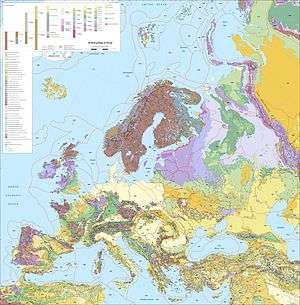European Cenozoic Rift System

The European Cenozoic Rift System (ECRIS) is an 1100 km long system of rifts formed in the foreland of the Alps as the lithosphere responded to the effects of the Alpine and Pyrenean orogenies. The system began to form during the Late Eocene and parts, particularly the Upper and Lower Rhine Grabens, remain seismically active today and are responsible for most of the larger earthquakes in Europe, north of the Alps.
Extent
The ECRIS consists of a series of rifts and associated transfer faults extending from the Mediterranean to the North Sea.[1]
Limagne Graben
This north-south trending rift structure formed in the middle Eocene creating a lake that is now the Limagne plain. The main phase of subsidence continued until the Late Oligocene. The graben is controlled by faults on its western side and has a fill of up to 2 km of Cenozoic sediments.[2]
Bresse Graben
The Bresse Graben lies to the east of the Limagne Graben. It initiated during the Eocene but the rifting stopped during the period from Late Oligocene to middle Miocene, but resumed in the Late Miocene. The eastern margin of the basin was overridden by thrust faults from the Jura Mountains, the leading edge of the alpine thin-skinned deformation.[2]
Upper Rhine Graben
The Upper Rhine Graben extends from the northern edge of the Jura mountains in the south up to the triple junction where the ECRIS branches. Rifting initiated here in the Oligocene but the northern and southern parts of the graben show distinct post-Oligocene histories. In the Miocene the southern part of the graben became uplifted, while the northern part continued to subside into the Pleistocene. Currently the Upper Rhine Graben is thought to be experiencing dextral strike-slip reactivation.[2]
Lower Rhine Graben
The Lower Rhine Graben or Lower Rhine Embayment, trends NW-SE and continues offshore into structures within the southern North Sea.[3] To the southeast the dominant faults are SW-dipping, while to the northwest they become NE-dipping, in both cases giving it a half-graben geometry. Rifting initiated during the Oligocene and continues to the present day.[2]
Hessian Grabens
The Hessian grabens lie north of the Upper Rhine Graben and follow the same trend. There are two main rift structures, the Wetterau and Leine grabens. They were active during the Oligocene but are inactive now.[1]
Eger Graben
The easternmost part of the system, the Eger Graben shows two distinct phases of extension at the end of the Eocene and during the early Miocene. The first phase was oblique to the rift axis and led to the formation of en-echelon W-E trending fault sets, The second was orthogonal to the rift axis, leading to overprinting of the early W-E faults by later SW-NE trending faults.[4]
Origin
The rift system is thought to have formed in response to compression of the lithosphere in front of the zones of collision that formed the Alps and Pyrenees. The initial rift propagated northwards as the collision along the Alps intensified and the western part of France moved to the west.[1]
Volcanism
The development of the ECRIS was accompanied (and in some cases preceded) by volcanic activity over large parts of the rift system that persisted into the Quaternary. The largest volcanic centres were located to the southwest of the Limagne and Bresse Grabens, the Massif Central, at the rift triple junction at the northern end of the Upper Rhine Graben, the Vogelsberg Mountains and around the Eger Graben.[2] The last recorded volcanic activity was a phreatomagmatic eruption in the Chaîne des Puys about 6,000 years ago.[5]
Seismicity
Most seismic activity within the ECRIS is confined to the Upper and Lower Rhine Grabens.[6][7] The 1356 Basel earthquake, which had an epicenter within the Upper Rhine Graben is the most damaging historical seismic event known from central Europe.[8]
References
- 1 2 3 Dèzes, P.; Schmid S.M.; Ziegler P.A. (2004). "Evolution of the European Cenozoic Rift System: interaction of the Alpine and Pyrenean orogens with their foreland lithosphere" (PDF). Tectonophysics. 389: 1–33. Bibcode:2004Tectp.389....1D. doi:10.1016/j.tecto.2004.06.011. Retrieved 2 June 2010.
- 1 2 3 4 5 Ziegler, P.A. (1990), Geological Atlas of Western Europe, Geological Society London, p. 256, retrieved 2 June 2010
- ↑ Zagwijn, W.H. (1989). "The Netherlands. during the Tertiary and the Quaternary: A case history of Coastal Lowland evolution" (PDF). Geologie en Mijnbouw. 68: 107–120. Retrieved 2 June 2010.
- ↑ Rajchl, M.; Uličný D.; Grygar R.; Mach K. (2009). "Evolution of basin architecture in an incipient continental rift: the Cenozoic Most Basin, Eger Graben (Central Europe)". Basin Research. 21 (3): 269–294. doi:10.1111/j.1365-2117.2008.00393.x. Retrieved 2 June 2010.
- ↑ "Chaîne des Puys". Global Volcanism Program. Retrieved 2 June 2010.
- ↑ Ahorner, L. (1983). "Seismicity and neotectonic structural activity of the Rhine Graben system in central Europe". In Ritsema A.R. & Gürpinar A. Seismicity and seismic risk in the offshore North Sea area: proceedings of the NATO advanced research workshop, held at Utrecht, the Netherlands, June 1–4, 1982. NATO advanced study institutes series. Series C, Mathematical and physical sciences. 99. Springer. pp. 101–111. ISBN 978-90-277-1529-6. Retrieved 2 June 2010.
- ↑ Meghraoui, M.; Delouis B.; Ferry M.; Giardini D.; Huggenberger P.; Spottke I.; Granet M. (2001). "Active Normal Faulting in the Upper Rhine Graben and Paleoseismic Identification of the 1356 Basel Earthquake" (PDF). Science. 293 (5537): 2070–2073. doi:10.1126/science.1010618. PMID 11557888. Retrieved 2 June 2010.
- ↑ Risk Management Solutions (2006). "1356 Basel Earthquake 650-Year Retrospective" (PDF). Retrieved 2 June 2010.
